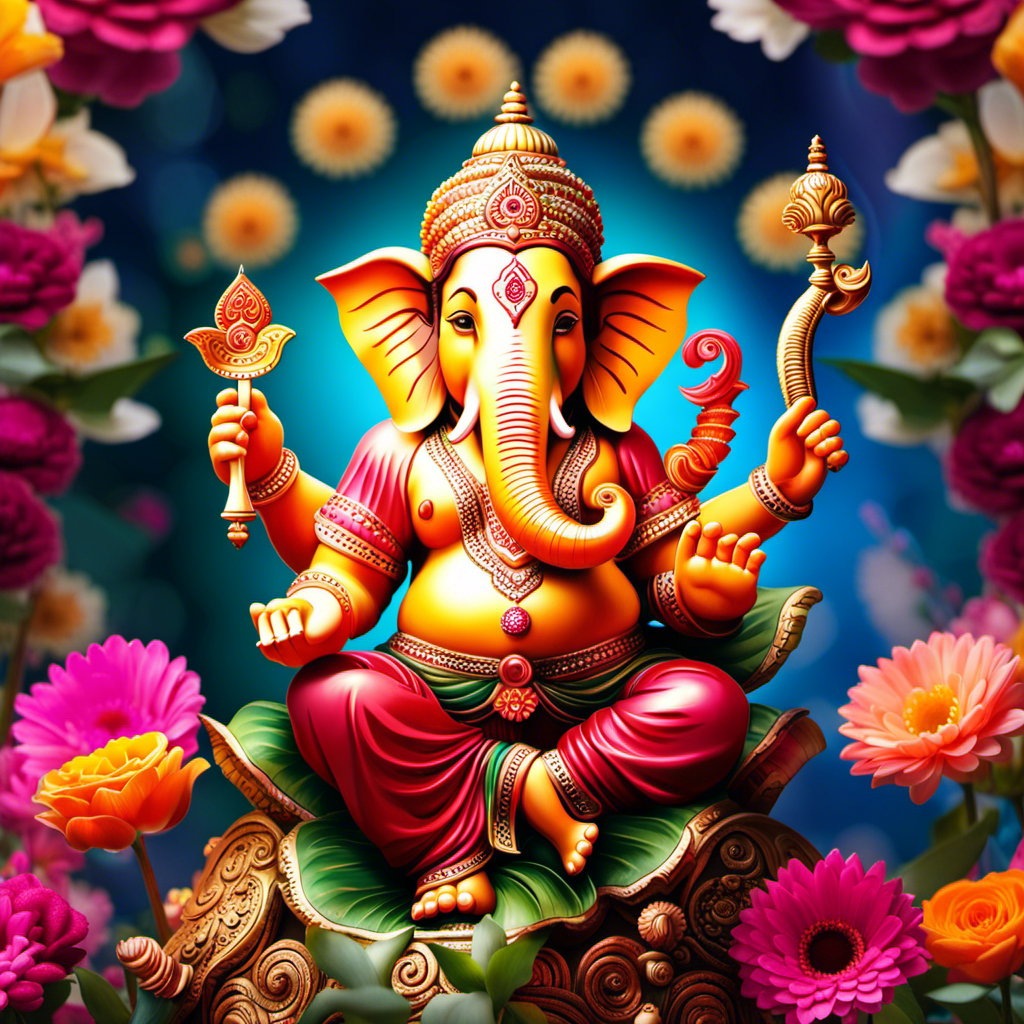Are you ready to discover the fascinating world of Ganesh?
Get ready for a whirlwind adventure as we delve into the origin, symbolism, and significance of this beloved Hindu deity.
From his iconic elephant head to his broken tusk and trusty mouse mount, Ganesh is full of surprises.
Join us as we explore famous temples dedicated to him and uncover his role in Hinduism and beyond.
Get ready for an enlightening journey filled with fun facts and newfound knowledge about Ganesh!
Key Takeaways
- Ganesh is one of the most widely worshipped deities in Hinduism, Buddhism, and Jainism.
- Ganesh is known by different names in different regions of India.
- Ganesh is often depicted with multiple arms, each holding symbolic objects.
- Ganesh is believed to be the god of wisdom, prosperity, and good fortune.
Origin and Mythology of Ganesh
Ganesh’s origin and mythology are fascinating to explore. In Hindu mythology, Ganesh is the son of Lord Shiva and Goddess Parvati. He is known as the elephant-headed deity, symbolizing wisdom and intellect. Ganesh’s association with these qualities makes him a revered figure among scholars and seekers of knowledge.
Legend has it that Ganesh was created by his mother using sandalwood paste, and she brought him to life to guard her privacy while she bathed. But when Lord Shiva returned home unexpectedly, he was stopped by Ganesh at the door. This led to a fierce battle between father and son, resulting in Ganesh losing his head. However, Lord Shiva later replaced it with an elephant head and bestowed upon him divine powers.
As the remover of obstacles, Ganesh brings good fortune to those who seek his blessings.
Symbolism Behind Ganesh’s Elephant Head
Did you know that the elephant head of Ganesh symbolizes wisdom and intelligence? It is not just a random choice, but holds deep cultural significance.
The elephant symbolism represents strength, power, and grace. Ganesh’s elephant head signifies his ability to overcome obstacles with wisdom and intellect. Imagine being able to tap into these qualities whenever you face challenges in your own life!
You too can embody the spirit of Ganesh by embracing knowledge and using it to navigate through difficult situations. Just as an elephant never forgets, let the symbolism of Ganesh’s elephant head remind you to always remember your inner strength and resilience.
Different Names and Depictions of Ganesh
There are various names and depictions of Ganesh that reflect the diverse cultural beliefs and traditions surrounding this beloved deity.
Each name carries its own meaning, evoking a sense of awe and wonder in those who chant them. Vighnaharta, the remover of obstacles, instills a feeling of hope and determination. Vinayaka, the leader of all beings, inspires confidence and strength. Gajanana, with his elephant head, symbolizes wisdom and intelligence.
Artistic representations further enhance our connection to Ganesh. As we gaze upon intricate sculptures or colorful paintings, we feel a sense of reverence for this divine being. The varied depictions allow us to explore different facets of his persona.
In this vast tapestry of traditions and beliefs, we find solace in knowing that no matter where we come from or what name we use to call him, Ganesh unites us all under his benevolent presence. Embrace the diversity within his different names and artistic representations; it is through these variations that our collective devotion grows stronger.
Ganesh Chaturthi – The Festival Celebrating Ganesh
During Ganesh Chaturthi, you can immerse yourself in the vibrant festivities and witness the joyous celebrations honoring this beloved deity.
The air is filled with excitement and devotion as people come together to celebrate Lord Ganesh, the remover of obstacles.
The highlight of these celebrations is the creation and immersion of beautifully crafted Ganesh idols. Skilled artisans create these idols using clay, bringing them to life with intricate details and vibrant colors. These idols are then worshipped with great reverence during the festival.
As you walk through the streets, you’ll be captivated by the sight of these magnificent idols adorning homes and pandals (temporary structures). The atmosphere is electric, as devotees sing devotional songs, perform rituals, and participate in processions to bid farewell to Lord Ganesh on the final day of the festival.
This celebration not only connects people with their cultural roots but also fosters a sense of belonging within a community that shares a deep love for Lord Ganesh.
Significance of Ganesh’s Broken Tusk
When you see Ganesh’s broken tusk, you’ll be reminded of the symbolic significance it holds in Hindu mythology. The tusk represents wisdom and the ability to overcome obstacles. According to one popular story, Ganesh broke his own tusk to use as a writing instrument when transcribing the epic Mahabharata for sage Vyasa. In another story, during a battle with the demon Gajamukhasura, Ganesh’s tusk was shattered as he fought bravely to protect the gods and restore balance in the universe. This broken tusk serves as a reminder that even in sacrifice, there is strength and transformation. It signifies Ganesh’s unwavering dedication to upholding righteousness and his willingness to do whatever it takes for the greater good.
| Symbolism | Stories |
|---|---|
| Wisdom | – Ganesh using his tusk as a writing instrument – Battle with Gajamukhasura |
| Strength | – Sacrifice for righteousness – Protecting gods in battle |
| Transformation | – Breaking of the tusk symbolizing change – Willingness to do whatever it takes |
Ganesh’s Vehicle – The Mouse
Did you know that the mouse, as a vehicle for Lord Ganesh, holds great symbolic significance in Hindu mythology?
The small and humble creature represents the ability to overcome obstacles with ease and adaptability.
In Hindu mythology, the mouse is believed to be a companion of Lord Ganesh, who rides on its back, showcasing his power and dominance over all hurdles in life.
Symbolic Significance of Mouse
You’ll be fascinated to learn that the mouse, serving as a vehicle for Lord Ganesh, symbolizes his ability to overcome obstacles and navigate through challenging situations. In Hindu mythology, the mouse holds deep symbolic significance, representing three key aspects of Lord Ganesh’s divine nature:
- Adaptability: Just like a mouse can squeeze through narrow spaces effortlessly, Lord Ganesh possesses the power to adapt to any situation. He teaches us the importance of being flexible and open-minded when faced with adversity.
- Intelligence: Mice are known for their quick thinking and problem-solving abilities. Similarly, Lord Ganesh is revered for his wisdom and intellect. He reminds us to use our minds wisely and seek knowledge in order to overcome life’s hurdles.
- Resourcefulness: Mice are resourceful creatures, always finding creative solutions even in difficult circumstances. Likewise, Lord Ganesh inspires us to tap into our inner resources and think outside the box when faced with challenges.
Embrace these qualities embodied by the mouse as you navigate your own life’s journey, overcoming obstacles with grace and resilience.
Mouse in Hindu Mythology
The mouse, serving as Lord Ganesh’s vehicle, symbolizes adaptability, intelligence, and resourcefulness in Hindu mythology. It represents the ability to navigate through life’s obstacles with ease and grace. Just like a mouse scurrying through tight spaces, Lord Ganesh is able to overcome any challenges that come his way.
In Hindu culture, animals often serve as vehicles for gods and goddesses. These animal vehicles not only add depth to the stories but also carry symbolic significance. For example, the peacock represents beauty and pride while the owl symbolizes wisdom and knowledge. Each animal has its own unique qualities that align with the deity it accompanies.
The use of animal vehicles in Hindu mythology highlights the interconnectedness between humans and nature, emphasizing our shared existence on this earth.
Famous Temples Dedicated to Ganesh
There’s a famous temple dedicated to Ganesh called Siddhivinayak Temple in Mumbai. It is not just any ordinary temple, but a place where miracles happen and wishes come true.
Let me take you on an enchanting journey across the globe to explore some of the most extraordinary Ganesh temples that exist.
- Ganapati Sachchidananda Ashram in Mysore, India: This serene ashram houses a magnificent 41-foot-tall statue of Lord Ganesh, attracting devotees from far and wide.
- Ashtavinayaka Temples in Maharashtra, India: These eight ancient temples are believed to be power spots where Lord Ganesh himself manifested in various forms.
- Shree Siddhivinayak Temple in Sydney, Australia: This vibrant temple is known for its grand celebrations during the annual Ganesh Chaturthi festival.
- Wat Saman Rattanaram Temple in Thailand: Here, you can witness a unique blend of Thai culture with Hindu traditions as devotees pay homage to the colossal four-faced Ganesha idol.
These remarkable temples remind us that no matter where we are in the world, we can always find solace and belonging through our devotion to Lord Ganesh.
Ganesh’s Role in Hinduism and Beyond
As you delve into the world of Ganesh, you’ll discover the profound symbolic significance that this deity holds. From being a remover of obstacles to representing wisdom and intellect, Ganesh embodies various aspects of life.
Beyond Hinduism, the cultural impact of Ganesh can be seen in art, literature, and even popular culture, making him a widely recognized and celebrated figure.
To understand the depth of devotion towards Ganesh, exploring the worship practices dedicated to him is essential. From elaborate ceremonies to personal rituals performed by millions around the world.
Symbolic Significance of Ganesh
Ganesh’s symbolic significance lies in his ability to remove obstacles and bring prosperity. His role in popular culture is undeniable, as he has become an icon of hope and inspiration. In modern art, Ganesh’s presence is ever-present, with artists capturing his beauty and power through various mediums. Imagine a vibrant painting of Ganesh, surrounded by colorful flowers and dancing devotees, symbolizing joy and celebration. This artwork evokes a sense of belonging, reminding us that we are part of something greater than ourselves. The table below showcases the diverse ways Ganesh is represented in modern art:
| Art Medium | Style | Emotion Elicited |
|---|---|---|
| Sculpture | Contemporary | Awe |
| Digital Art | Surrealistic | Wonder |
| Mural Painting | Abstract Expressionism | Inspiration |
Through these artistic representations, Ganesh connects with people on a deeper level, fostering a sense of unity and belonging within the community.
Cultural Impact of Ganesh
The cultural impact of Ganesh can be seen through the widespread celebration and reverence for him in various communities. His influence has transcended boundaries and permeated into different aspects of society, leaving a lasting imprint on people’s lives.
Ganesh has become an iconic figure, representing wisdom, prosperity, and good fortune. In popular representations, he is often depicted with an elephant head and a potbelly, symbolizing abundance and fertility.
His presence is felt during festivals like Ganesh Chaturthi, where devotees come together to celebrate his birth with elaborate processions and rituals.
The cultural influences of Ganesh extend beyond religious practices as well. He has inspired art forms such as painting and sculpture, with artists showcasing their creativity by depicting him in unique ways.
Through these expressions of devotion and artistic interpretations, Ganesh continues to foster a sense of belonging among individuals who find solace in his divine presence.
Worship Practices for Ganesh
You can learn about worship practices for Ganesh by observing the rituals and traditions followed during festivals like Ganesh Chaturthi. The celebration of Ganesh Chaturthi is a vibrant and joyous affair, where devotees come together to honor Lord Ganesh in various ways.
Here are some different forms of Ganesh worship that you might witness:
- Pooja: Devotees perform elaborate poojas, offering flowers, fruits, sweets, and incense to Lord Ganesh.
- Aarti: Aarti is a beautiful ceremony where lamps are lit, and prayers are sung to seek blessings from the deity.
In modern society, Lord Ganesh holds immense significance. He represents wisdom, prosperity, and success. People turn to him for guidance and support in their endeavors. His presence brings a sense of belonging and unity among communities during festivals.
Through his worship practices, individuals find solace and strength in their spiritual journey with Lord Ganesh by their side.
Frequently Asked Questions
How Many Arms Does Ganesh Have?
Ganesh has multiple arms, symbolizing his ability to accomplish many tasks. In Hindu mythology, he is known as the remover of obstacles and the god of wisdom. His unique appearance adds to his significance and role in religious rituals.
Is Ganesh Considered a God or a Deity?
Ganesh is considered both a god and a deity, embodying wisdom, knowledge, and prosperity. In Hindu mythology, Ganesh’s significance lies in his ability to remove obstacles and bring good fortune. His symbolism in art reflects the belief in his divine power.
What Are Some Other Festivals Celebrated in Honor of Ganesh?
During Ganesh Chaturthi, people celebrate the birth of Lord Ganesh by creating beautiful idols and offering prayers. The festival ends with Ganesh Visarjan, where devotees immerse the idols in water bodies to symbolize his return to Mount Kailash.
What Is the Story Behind Ganesh’s Broken Tusk?
The story behind Ganesh’s broken tusk is fascinating. It symbolizes sacrifice, wisdom, and the power to overcome obstacles. It reminds you that even in adversity, there is strength and growth waiting to be discovered.
Can Ganesh Be Worshipped by People of Other Religions?
Yes, Ganesh can be worshipped by people of other religions. His interfaith worship is a testament to his cultural significance and the inclusive nature of his teachings. Embrace the unity and belonging that Ganesh offers.
Conclusion
Congratulations! You have now embarked on a magical journey exploring the captivating world of Ganesh. From his origin and mythology to the symbolism behind his elephant head, you have gained insight into the fascinating aspects of this beloved deity.
As you discovered different names, depictions, and famous temples dedicated to Ganesh, your understanding deepened. And let us not forget about Ganesh Chaturthi, the grand festival celebrating him!
With his broken tusk and trusty mouse as companions, Ganesh continues to play a vital role in Hinduism and beyond. So embrace the wisdom and blessings he bestows upon us all!





